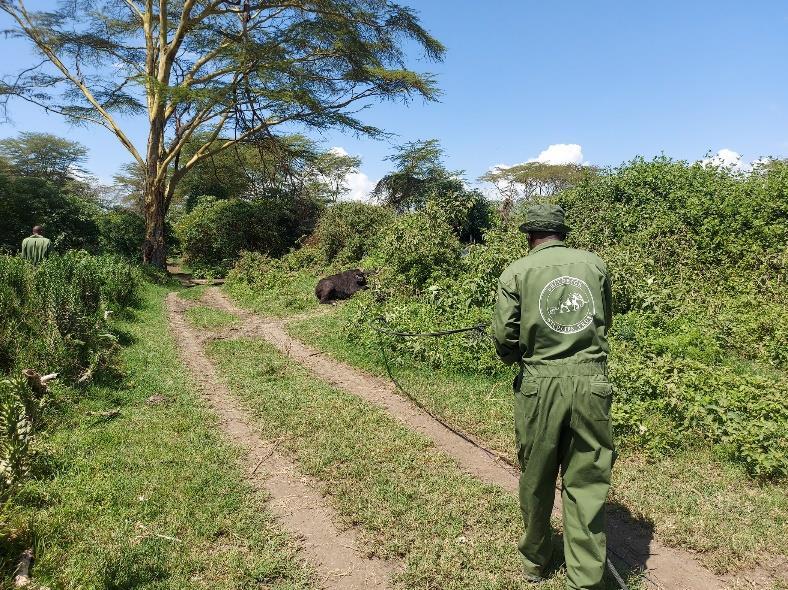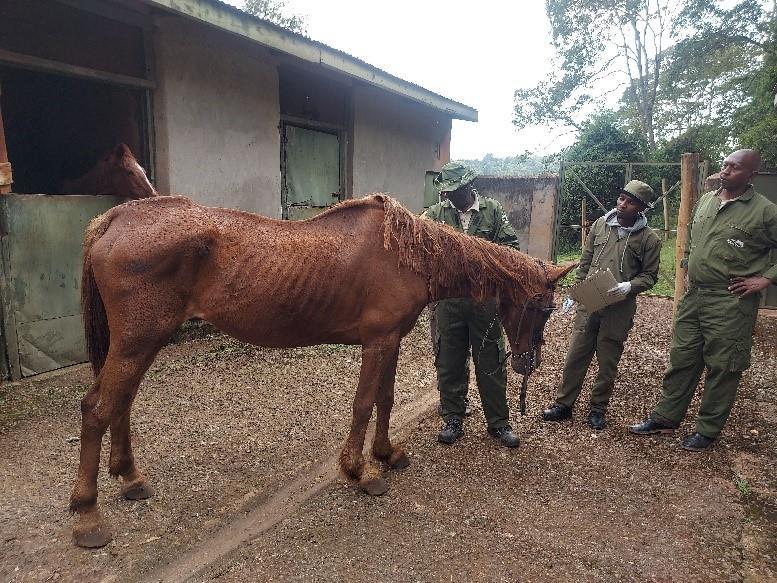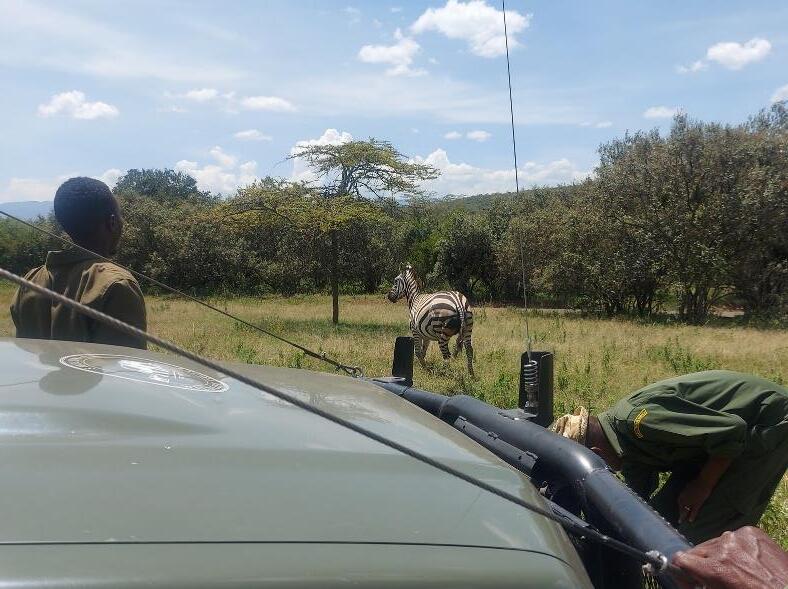
SWT/KWS RIFT VALLEY MOBILE VETERINARY UNIT
JANUARY 2024




JANUARY 2024



13 Cases in January
January Report by Dr. Titus Kaitho1 Lion Case

1 Elephant Case
Seasonal rains fell across the Central Rift Conservation Area in general and the areas north and south of Lake Naivasha over the reporting period. The SWT/KWS Rift Valley Mobile Veterinary Unit attended to 13 Cases in January 2024 This included 1 elephant case, 1 lion case, 2 Masai giraffe cases, 3 buffalo cases, 4 common zebra cases and treatment of 2 security horse cases and a security dog.
The Rift Valley Mobile Veterinary team greatly appreciates The Brady Hunter Foundation for funding the Unit through the Sheldrick Wildlife Trust (SWT). The team acknowledges Angela Sheldrick, CEO -SWT for her unwavering support and interest in the work undertaken by the Mobile Veterinary Unit and thanks the Wildlife Research & Training Institute (WRTI) for hosting the Unit at WRTI - Naivasha. The team additionally thanks all the stakeholders and scouts who reported wildlife in distress and supported the veterinary interventions in this report. Thank you all.

03-Jan 24
to 14-Jan 24
Giraffe Wileli Conservancy Relocation Translocation of 3 female Masai Giraffes to Bora Bora Wildlife Sanctuary, Kwale Task successful
05-Jan 24 Zebra Aquilla Farm Natural Causes Lame adult female common zebra
11-Jan 24 Elephant Maasai Mara N.R. Spear
Adult elephant bull with a spear lodged in the left flank close to the hind leg
15-Jan 24 Giraffe Oserengoni Sanctuary Snared Adult female Masai Giraffe with a long wire snare on the left hind leg
Successfully treated
Successfully Treated
Successfully treated
16-Jan 24 to 18-Jan 24 Lion Hell’s Gate N.P. HWC Searching for a stray lion in Hell's Gate National Park using call back stations Not Located
18-Jan 24
Security Dog WRTI Canine Unit Technical Case Assessment of the suitability for service of 4 security dogs Task successful
21-Jan 24 Zebra Sopa Lodge Snared
Adult male zebra tethered to a tree by a wire snare around the neck and limb
Successfully treated
22-Jan 24 Buffalo Nini Farm HWC Rescuing an adult female buffalo that was trapped after falling into a dam Task successful 22-Jan 24 Zebra Sopa Lodge Snared
27-Jan 24 Security Horse Mt. Elgon
Adult male common zebra with a long wire snare around the neck Successfully treated
Natural Causes Treated for worms and advised supplement feeding Successfully Treated
30-Jan 24 Zebra Colors Farm Natural Causes
30-Jan 24 Buffalo WRTI Main Campus HWC
Adult female common zebra wounded by a predator on the perineum. Successfully treated
Adult female buffalo found dead after being trapped by a makeshift wooden bridge HWC Death
Adult female buffalo with a rope snare on the right front limb tethering it to a post Successfully treated
January 2024


The Rift Valley Mobile Veterinary Unit in conjunction with the KWS Veterinary Department translocated 3 female Masai Giraffes to Bora Bora Wildlife Sanctuary to augment the 2 male Masai Giraffes in the Sanctuary. Two (2) female giraffes were captured in Wileli Wildlife Conservancy on 03/01/2024 which borders Moi Ndabi community land while the other female Masai Giraffe was captured in Marula Estates on 04/01/2024
The giraffes were habituated in a holding boma to minimize stress from capture during transportation. They were translocated to Bora Bora Wildlife Sanctuary on 14/01/2024. Additionally, two (2) mature male Masai Giraffes that had strayed into the Moi Ndabi community land giving rise to conflict were driven by vehicles and foot, for approx. 2 Km, to Wileli Wildlife conservancy.
Capture and translocation
The female Masai giraffes were each darted with a combination of 10mg Etorphine and 50mg Azaperone. The average induction time was 8 minutes. The giraffes were gently roped to ground once the drugs took effect. Anaesthesia was quickly reversed with a 225mg Naltrexone intravenous injection. The giraffes were quickly blindfolded, their ears were plugged, and they were physically restrained. A physical examination was carried out, blood and faecal samples were then obtained from all immobilized giraffes. In addition, preventive treatment with Ivermectin and multivitamin was given parenterally. The giraffes were skilfully guided into a loading crate then the crates were towed by a farm tractor to the holding boma
The 3 female giraffes were held and monitored in the holding boma from 03rd January 2024 to 14th January 2024. Water, natural browse, and mineral blocks were provided ad lib. The giraffes’ diet was also supplemented progressively with lucerne cubes.
On 14/01/2024, the 3 giraffes were translocated from the holding boma at Wileli Wildlife conservancy to Bora Bora Wildlife Sanctuary in Kwale County. Assessments were done at regular intervals during the 650Km journey to ensure the animals were comfortable. At the release site the 3 female giraffes walked out of the truck voluntarily through an off-loading ramp and later joined one resident male.


Aquilla Farm security staff reported sighting a lame female common zebra.


The zebra was darted with 5mg Etorphine and 80mg Azaperone.
Upon examination, an inflammation of the right hind leg hock joint was found to be the cause of the zebra’s lameness. 250mg Flunixin Meglumine, 12,000mg Oxytetracycline, and 40ml Catasol were administered intramuscularly while 5ml Ivermectin was administered subcutaneously. Anaesthesia was thereafter reversed with 75mg Naltrexone given intramuscularly and intravenously.
The zebra has a good prognosis.


Masai Mara National Reserve Security Warden reported sighting an elephant bull with a spear lodged in the right flank.


The elephant was immobilized with 17mg Etorphine Induction time was 8 minutes. The elephant bull had a spear lodged in its left flank close to the hind leg.
The spear had penetrated the abdomen and abdominal gases were escaping from the 30 cm deep wound.
The wound was cleaned with water and rinsed with Iodine. A fly repellent was topically applied on the wound. 1,000 mg Flunixin Meglumine and 15,000 mg Amoxicillin were administered intramuscularly, 20 ml Ivermectin was also administered subcutaneously. General anaesthesia was reversed post-treatment with 250 mg Naltrexone, ¾ was given intravenously and ¼ was injected intramuscularly.
Prognosis
The elephant bull has a favourable to guarded prognosis.


Giraffe Snared Oserengoni Wildlife Sanctuary
Kongoni Game Valley staff reported a snared adult female Masai giraffe.


The snared female giraffe was darted with 14 mg Etorphine and 80 mg Azaperone and assumed recumbency in cactus thorns.
The long wire snare on the left hind leg was briskly cut loose with wire cutters and anaesthesia immediately reversed with 250 mg Naltrexone given intravenously. Fortunately, the snare had not injured the giraffe’s limb.
Prognosis
The giraffe has a good prognosis.
Case 5 – 16th January 2024 to 18th January 2024
Lion Human – Wildlife Conflict Hell’s Gate National Park
From 16th January 2024 to 18th January 2024, the Rift Valley Mobile Veterinary Unit searched for a stray lion in Hells Gate National Park. Unfortunately, the team failed to sight any lion using a callback station. The veterinary team advised that lion monitoring continues through spoors, roars, and kills in the National Park
On 18th January 2024, the Rift Valley Mobile Veterinary Unit in collaboration with Canine Master Sang, Canine Handler Rgr Mbogo, and Cpl Ng’ang’a evaluated 4 security dogs for suitability for service.
Haiko, a 11-year-old male Belgian Malinois attacker/tracker dog, was found to have served well. KWS has used him in attack demos. He had become old and lame due to arthritis. He also had a chronic ear infection and chronic pain The team recommended that Haiko be retired or put to rest on animal welfare grounds.
Whisky, a 11-year-old female Belgian Malinois attacker/tracker dog, had served in Lake Nakuru National Park since 2015. Her performance has been excellent. The team recommended that Whisky be retired or put to rest. She had developed a swelling suspected to be a mammary gland tumour which was spreading fast to other organs
Daisy, a 2-year-old Belgian Malinois had been designated as a tracker puppy. However, she was found to be untrainable and very timid. She was not able to face anyone and feared everything. The team recommended that Daisy be rehomed since she is not useful to KWS.
Meshak, a 2-year-old Labrador had been assigned as a tracker dog. However, Meshak was not trainable. He was in good health, but he was also very playful and lacked courage. The team recommended that he be rehomed as a companion/ pet dog since he is not useful to KWS.




The KWS investigations team reported that an adult female common zebra had been tethered to a tree by a snare at Sopa Lodge opposite Kedong Ranch. The Rift Valley Mobile Veterinary Unit responded to this emergency case at night.
Immobilisation, examination and treatment
The zebra was darted with 5 mg Etorphine and 80 mg Azaperone.
Upon examination the zebra was found to have a long wire snare around the neck that had also entangled its limb. The zebra had suffered self-inflicted injuries as it tried to set self-free. 250 mg Flunixin Meglumine and 9,000 mg Amoxicillin were administered intramuscularly then anaesthesia was reversed with 75 mg Naltrexone given intravenously and intramuscularly.
Prognosis
The zebra has a good prognosis

Nini Farm staff reported that an adult female buffalo had fallen into a dam and was unable to get out.


The veterinary team tactfully looped a winch over the animal’s horns and tethered the other end to a post near the wall of the dam. This secured the trapped buffalo and prevented it from drowning under general anaesthesia. The buffalo was then darted with 8 mg Etorphine and 80 mg Azaperone. The team carefully walked the sedated buffalo towards the wall of the dam by pulling the tethered animal with a vehicle. This was successful. The buffalo assumed recumbency outside the dam on dry ground. The team promptly removed the winch from the horns and reversed anaesthesia with 150 mg Naltrexone given intravenously and intramuscularly. The buffalo stood a short while later and joined a nearby herd.
Prognosis
The buffalo has a good prognosis.


This case was reported through KWS investigation team by Sopa Lodge staff.
The adult male common zebra was immobilized with 5 mg Etorphine and 80 mg Azaperone.
The animal had a long winch wire snare, approx. 1.5 meters long, around its neck. Fortunately, the snare was loose, and it had not inflicted any injury on the zebra’s neck. The snare was removed then anaesthesia was reversed with 75 mg Naltrexone given intramuscularly and intravenously.
The zebra has a good prognosis.

Two horses required medical attention at Mt Elgon National Park. Gaseous, a male security horse, was reported to be weak and breathing fast. He had also developed poor exercise endurance. Flamingo, a female horse was also in poor condition and required treatment and de-worming
Examination and treatment
Gaseous had a poor body condition score He was lethargic, and he had a high respiratory rate His breathing was laboured, and harsh lung sounds were heard on auscultation of the chest. Gaseous was diagnosed with pneumonia. 650mg Flunixin Meglumine, 9,000mg Amoxicillin and 40ml Catasol were administered intramuscularly. 10ml Ivermectin was also administered subcutaneously.
Flamingo was also given 10 ml Ivermectin subcutaneously and 40ml Catasol intramuscularly.
Prognosis
Gaseous has a favourable to guarded prognosis and Flamingo a good prognosis The veterinarian advised feed supplementation with hay ad-lib plus maize germ & wheat bran up to 7 Kg per day. It was also recommended that their diet also includes a mineral lick.




Colors Crops Farm security staff, through the KWS investigations team, reported an injured adult female common zebra.


The zebra was immobilized with 5mg Etorphine and 80mg Azaperone.
Upon examination, the zebra was found to have been wounded by a predator on the perinium. The wound was infested with maggots. The wound was cleaned with water and rinsed with tincture of Iodine then a fly repellent (Alamycin® Aerosal) was applied topically. 250mg Flunixin Meglumine, 9,000mg Amoxicillin and 40ml Catasol were administered intramuscularly. 5ml Ivermectin was also administered subcutaneously.
Prognosis
Anaesthesia was reversed post-treatment with 75 mg Naltrexone given intramuscularly and intravenously.
The zebra has a good prognosis.


WRTI staff reported that an adult female buffalo was trapped at a temporary wood bridge


Examination
Upon arrival, the Rift Valley Mobile Veterinary Unit found the buffalo was already dead.
The buffalo had been trapped by the wooden planks as it tried to cross this makeshift wooden bridge. The team disposed of the carcass away from the bridge, and strongly recommend that the bridge be repaired since it had become a death trap for wildlife.


Buffalo Snared Kenya Nut – Olmurogi Area
An informer reported that an adult female buffalo had been snared at Kenya Nut - Olmurogi Area


The buffalo was darted with 9mg Etorphine and 80mg Azaperone.
The animal had been tethered to a wooden post by a mooring rope The snare was removed then anaesthesia was reversed with 150 mg Naltrexone given intravenously and intramuscularly.
Prognosis
The buffalo has a good prognosis.